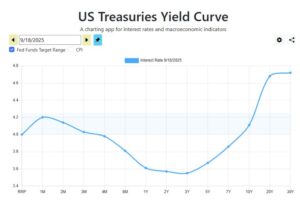Interest rates are coming down?
At Tuesday’s Fed meeting, the Board of Governors voted to lower interest rates by 25 basis points, and will now be targeting a range of 4.00% – 4.25%. They also hinted, in typical Fed speak, that additional modest rate cuts would be expected later this year. While this outcome was largely anticipated by financial markets, it is still a positive economic indicator. Generally speaking, when interest rates fall:
- Mortgage rates are likely to come down, giving Americans some budgetary relief as they refinance.
- Americans will be more likely to tap into their home equity, which could increase consumer spending.
- Corporations will potentially invest more aggressively.
- Investors should expect to earn less interest rates on bonds, money market funds, and bank CDs, pushing them more towards equities.
- Inflation becomes a question. Will lower interest rates cause inflation?
Below is a chart of the US Treasuries Yield Curve. It shows what interest rates are at given times of maturity and is a predictor of where interest rates are heading.
 At the left-hand side, bonds maturing in one month have a 4.2% interest rate. In the middle of the chart, the dip shows interest rates around 3.6%, and then it climbs back up to nearly 5% for long-dated maturities like the 30-year bond. That is all to say, the bond market predicts that interest rates will fall to 3.6% over the next 1-3 years. However, long-term, interest rates are expected to increase. To put it in more practical terms, we would expect that over the next 2-3 years, your high yield savings account will pay between 3.0% – 3.5% interest and you may be able to refinance your home at around 5% interest.
At the left-hand side, bonds maturing in one month have a 4.2% interest rate. In the middle of the chart, the dip shows interest rates around 3.6%, and then it climbs back up to nearly 5% for long-dated maturities like the 30-year bond. That is all to say, the bond market predicts that interest rates will fall to 3.6% over the next 1-3 years. However, long-term, interest rates are expected to increase. To put it in more practical terms, we would expect that over the next 2-3 years, your high yield savings account will pay between 3.0% – 3.5% interest and you may be able to refinance your home at around 5% interest.
We pay attention to things like Treasury Yield Curves so you don’t have to!
— Sam Plotkin, CFA
